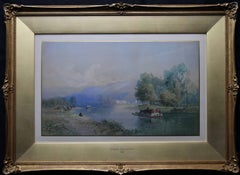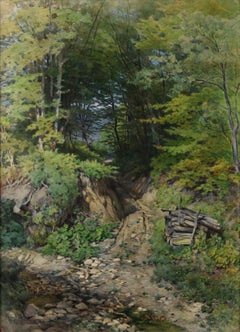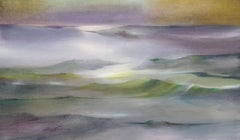Edward Richardson Art
to
1
1
1
1
Overall Height
to
Overall Width
to
1
1
6,952
3,302
2,514
1,213
1
1
Artist: Edward Richardson
Swiss Rhine Landscape - British Victorian art watercolour painting riverscape
By Edward Richardson
Located in London, GB
This lovely British 19th century watercolour landscape painting is by highly regarded and much exhibited artist, Edward Richardson. The artist was noted for his British and European ...
Category
19th Century Realist Edward Richardson Art
Materials
Watercolor
Related Items
Shady hollow way - Into the heart of the forest -
By Hans Dvoràk
Located in Berlin, DE
Hans Dvořák (19th century). Shady hollow way in a sunny forest. Watercolour and pen-and-ink drawing, 58.5 x 43 cm (visible size), 70 x 55.5 cm (frame), signed and dated "Hans Dvořák ...
Category
1880s Realist Edward Richardson Art
Materials
Watercolor
Waves. Watercolor, paper, 55 x 93 cm
By Zigmunds Snore
Located in Riga, LV
Waves. Watercolor, paper, 55 x 93 cm
Zigmunds Šņore was born in 1942 in Latvia. His works has been exhibited since 1969 and are held in private collections in Latvia, USA, Sweden, ...
Category
2010s Realist Edward Richardson Art
Materials
Watercolor, Paper
Raft Landscape in Sweden / - Temporary structures -
Located in Berlin, DE
Otto Eglau (1917 Berlin - 1988 Kampen), Raft Landscape in Sweden, 1956. Watercolor and ink on paper, 45 x 60 cm, signed in his own hand lower right with "Eglau" and dated "[19]56".
- somewhat darkened
Exposé as PDF
- Temporary structures -
About the artwork
A wide river landscape stretches out before us, its horizon line running across the upper part of the picture, creating the impression of enormous depth. The depth is further extended by the dark tree trunks, most of which spill into the picture, and at the same time rhythmized by their different positions. This sequence of movements gives the landscape a strong dynamic moment. Indeed, the landscape seems to be "fleeing" from beneath us. To keep the gaze on the foreground alone requires a real visual effort. By looking at the foreground, we have already arrived at the background. Therefore, we cannot speak of pictorial grounds in the classical sense. Rather, we are confronted with a structurally rhythmic continuum of space, the dynamics of which are further accelerated by the cut tree trunks in the foreground and the upright trunks in the background, which function as target marks.
Since the narrow strip of sky has the same white tonality as the ice, this area also fits seamlessly into the spatial structure, so that a deserted "structural landscape" unfolds before us. The structure, however, is not - as in the case of Piet Mondrian - completely abstract and thus something that exists independently of itself, removed from the time of natural space. The structures that Otto Eglau discovered in nature remain bound to it, which is why they exhibit a temporality that corresponds to the 'course of things'. Even if they correspond to an architecture of nature brought to representation, the structures are not substantial, but contingent. Artistically uncovered, they present themselves to Eglau at the very moment he captures them. In nature itself, these structures will never be repeated in the same way. Panta rhei - everything flows, even if the flow of time is frozen by his artistic representation and the image, for all its dynamism, radiates calm at the same time.
"The structures I put behind things, and the lines that hold my paintings, are signs of transient life. They are random like the trace a wave leaves in the sand, blurred like the border between sea and land, ephemeral like the life of a shell I hold in my hand."
- Otto Eglau
About the artist
After his release from captivity in 1947, Otto Eglau studied at the Hochschule für Bildende Künste in Berlin. He was a student of Oskar Nerlinger, Max Kaus and Wolf Hoffmann. From 1953 he taught free drawing for architects at the Technical University of Berlin. In the years that followed, Eglau undertook numerous study trips that took him to Scandinavia, the Arab world, the Far East and even Macau. During these travels he cultivated the technique of watercolour, which allowed him to work quickly in the open air, while retaining a strong painterly quality.
Scholarships enabled Eglau to stay in Japan from 1962 to 1963 and in Naples in 1970. From 1969 to 1976 Eglau was professor of etching at the International Summer Academy of Fine Arts in Salzburg. Between 1983 and 1988 Eglau worked simultaneously in his Berlin studio at Lietzensee, which had its own printing press, and in his studio in Kampen on the island of Sylt.
Otto Eglau's work has been shown in more than 100 solo exhibitions worldwide and in more than 120 group exhibitions.
"I love the vastness of the island. The mudflats off Kampen are my treasure trove; here I discover new shapes and colors every day. Without Sylt, I would be like a fish without water."
- Otto Eglau
Selected Bibliography
Hanns Theodor Flemming: Otto Eglau. Das graphische Werk, Flensburg 1966.
Heinrich Seemann (Einführung): Otto Eglau. Inselskizzen, Hamburg 1982.
Heinrich Seemann (Einführung): Otto Eglau. Japan, Nepal, Sylt. Aquarelle. Zeichen und Strukturen. Einführung von Heinrich Seemann, Hamburg 1986.
Otto Eglau: Watt-Tagebuch. Ausgewählte Aquarelle aus den Skizzenbüchern Otto Eglaus. Kampen 1996.
GERMAN VERSION
Otto Eglau (1917 Berlin – 1988 Kampen), Floßlandschaft in Schweden, 1956. Aquarell und Tusche auf Papier, 45 x 60 cm, unten rechts eigenhändig in Blei mit „Eglau“ signiert und mit „[19]56“ datiert.
- etwas nachgedunkelt
Exposé als PDF
- Temporäre Strukturen -
zum Werk
Vor uns erstreckt sich eine weite Flusslandschaft, deren Horizontline im oberen Bereich des Bildes verläuft, wodurch der Eindruck einer enormen Tiefenerstreckung entsteht. Die Tiefe wird von den dunklen, zumeist ins Bild hineinfluchtenden Baumstämmen zusätzlich geweitet und – durch ihre verschiedenartigen Lagen – dabei zugleich rhythmisiert. Durch diese Bewegungsabfolge weist die Landschaft ein starkes dynamisches Moment auf. Und tatsächlich stellt sich der Eindruck ein, als ob die Landschaft unter uns ‚hinwegfluchten‘ würde. Den Blick einzig im Vordergrund zu halten, verlangt regelrecht eine visuelle Anstrengung. Auf den Vordergrund schauend sind wir bereits im Hintergrund angelangt. Daher kann gar nicht von Bildgründen im klassischen Sinne gesprochen werden. Vielmehr steht hier ein strukturell rhythmisiertes Raumkontinuum vor Augen, dessen Dynamik von den angeschnittenen Baumstämmen vorne und den als Zielmarken fungierenden aufgerichteten Stämmen hinten zusätzlich beschleunigt wird.
Da der schmale Himmelstreifen dieselbe Weißtonalität wie die Wasserlandschaft aufweist, fügt sich auch dieser Bereich bruchlos in das Raumgefüge ein, so dass sich vor uns eine menschenleere ‚Strukturlandschaft‘ ausbreitet. Die Struktur ist aber nicht – wie dies bei Piet Mondrian der Fall ist – gänzlich abstrakt und dadurch etwas eigenständig für sich Bestehendes, das der Zeit des Naturraums enthoben ist. Die von Otto Eglau in der Natur entdecken Strukturen bleiben an diese zurückgebunden, weshalb sie eine dem ‚Lauf der Dinge‘ entsprechende Temporalität aufweisen. Auch wenn sie einer zur Darstellung gebrachten Architektur der Natur entsprechen, sind die Strukturen nichts Substanzielles, sondern kontingent. Künstlerisch aufgedeckt, bieten sie sich Eglau in eben jenem Moment dar, den er festhält. In der Natur selbst werden diese Strukturen niemals in derselben Art wiederkehren. Panta rhei – alles fließt, auch wenn sich der Fluss der Zeit durch seine künstlerische Darstellung verfestigt hat, wodurch das Bild – trotz aller Dynamik – zugleich auch Ruhe ausstrahlt.
„Die Strukturen, die ich hinter die Dinge setze, und die Linien, die meine Bilder halten, sind Zeichen des vergänglichen Lebens. Sie sind zufällig wie die Spur, die eine Welle im Sand hinterlässt, unscharf wie die Grenze zwischen Meer und Land, vergänglich wie das Leben einer Muschel, die ich in der Hand halte.“
- Otto Eglau
zum Künstler
Nach seiner Entlassung aus der Kriegsgefangenschaft 1947 nahm Otto Eglau ein Studium an der Hochschule für Bildende Künste in Berlin auf. Dort war wer Schüler von Oskar Nerlinger, Max Kaus und Wolf Hoffmann. Ab 1953 unterrichtete er freies Zeichnen für Architekten an der Technischen Universität Berlin. In den Folgejahren unternahm Eglau zahlreiche Studienreisen, die ihn nach Skandinavien, in den arabischen Raum, nach Fernost und bis nach Macau führten. Auf diesen Fahrten kultivierte er die Technik des Aquarellierens, die eine zügige Bildschöpfung im Freiraum erlaubt und dennoch eine stark malerische Qualität aufweist.
Stipendien ermöglichten es Eglau, sich von 1962 bis 1963 in Japan aufzuhalten und 1970 länger in Neapel zu verweilen. Von 1969 bis 1976 hatte Eglau die Professur für Radierung an der Internationalen Sommerakademie für Bildende Kunst in Salzburg inne. Zwischen 1983 und 1988 war Eglau parallel in seinem Berliner Atelier am...
Category
1950s Realist Edward Richardson Art
Materials
Watercolor
Cross Place du Village Watercolor Painting by C Koella c1897 19th Century
Located in FR
Cross Place du Village Watercolor Painting by C Koella c1897 19th Century
Saas Switzerland
E Vouga from Geneva is the previous owner
Good antique condition with a small tear on one...
Category
1890s Realist Edward Richardson Art
Materials
Paper, Watercolor
The Maamturk Mountains from Recess, Connemara, Ireland. Framed Irish Watercolor.
Located in Sutton Poyntz, Dorset
Frank J. Egginton.
British ( b.1908 - d.1990 ).
The Maamturk Mountains from Recess, Connemara, Ireland
Watercolor.
Signed lower left.
Image size 20.5 inches x 29.1 inches ( 52cm x 74cm ).
Frame size 27.6 inches x 36 inches ( 70cm x 91.5cm ).
Available for sale is this original watercolour by the British artist Frank Egginton which dates from the 1970s.
The painting is presented and supplied in a sympathetic contemporary frame (which is shown in these photographs), mounted using conservation materials and behind non-reflective Tru Vue UltraVue® UV70 glass.
This vintage painting is in very good condition, it wants for nothing and is supplied ready to hang and display.
The watercolor is signed lower left.
Frank Egginton was a British contemporary landscape artist, synonymous with watercolours of the Irish countryside, particularly county Donegal. He came from an artistic family, with his father being the well-known artist Wycliffe Egginton (1875-1951), and his nephew was the artist Robert Egginton. His daughter and son in law have run The Gallery in Dunfanaghy, Co. Donegal for many years.
Frank (officially Francis John) Egginton was born in Wallasey in the county of Cheshire on 10 November 1908. When he was a baby the family moved to Newton Abbott in Devon, as his father had been appointed headmaster of the College of Art there.
Frank was educated at Newton College, and then Newton Abbott College of Art, and Exeter School of Art. He then spent some time perfecting his drawing whilst working in an architect’s office. In 1921 the family moved again to Teignmouth in Devon.
In 1930 Egginton visited Co. Donegal and painted some pictures for a businessman friend of his father’s. He developed a love of the west Irish...
Category
Mid-20th Century Realist Edward Richardson Art
Materials
Watercolor
H 27.56 in W 36.03 in D 1.28 in
"Great Pine", Tree Inhabited by Human in Nature, Drawing and Pigments on Paper
By Frank Girard
Located in Clermont-Ferrand, Auvergne-Rhône-Alpes
This drawing by Frank Girard is created with pigments, Chinese ink, watercolors, acrylic, and colored pencils on 300g/m2 neutral white paper. It is not fr...
Category
2010s Realist Edward Richardson Art
Materials
Paper, Color Pencil, Acrylic, Ink, Watercolor, Pigment
H 25.6 in W 19.69 in D 0.02 in
Wettersteinkamm - The blue of the mountains -
Located in Berlin, DE
Adalbert Holzer (1881 Munich - 1966 Munich). Wettersteinkamm. Watercolour, 29 x 34.5 cm (visible size), 37.5 x 43 cm (frame), signed and dated at lower right 'ADALBERT HOLZER [19]23'.
Framed behind glass. Frame shows signs of wear.
- The blue of the mountains -
About the artwork
The Wetterstein ridge is revealed to the viewer from a gentle, snow-covered hill. In contrast to conventional depictions of mountains, the painting is composed entirely of shades of blue, which condense into the blue-grey of the rock or fade into the white of the snow. As a complementary colour to the blue, Holzer virtuously activates the ochre ground. The uniform yet exciting polarity of the colours emphasises the massive majesty of the mountains and at the same time underlines the special character of the Wetterstein ridge. Holzer transferred the translucency of glass painting, in which he was originally trained, to watercolour and developed a pictorial language related to the art of Ferdinand Hodler, which earned him the nickname 'Master of Blue' and led to the appreciation of his watercolours in particular.
About the artist
After an apprenticeship as a stained glass painter at the Kunstgewerbeschule, Adalbert Holzer studied at the Munich Art Academy under Carl von Marr...
Category
1920s Realist Edward Richardson Art
Materials
Watercolor
High Moorland Landscape in the fog - The world as a transcendent phenomenon -
Located in Berlin, DE
Charles Edward Brittan Jr (1870 Plymouth - 1949). High moor landscape in the fog. Gouache, signed at lower left "Charles E. Brittan", 18 x 34.5 cm (passepartout), 45 x 62 cm (frame)....
Category
Early 20th Century Realist Edward Richardson Art
Materials
Watercolor
H 17.72 in W 24.41 in D 1.58 in
Wind Dodgers at the Baltic Sea
Located in Berlin, DE
Theodor Scheerbaum (1897 Reichenbach im Vogtland), Wind Dodgers at the Baltic Sea. Watercolor on strong yellowish grained paper, 44 x 56 cm, signed by hand "Th[eodor] Scheerbaum" at ...
Category
1950s Realist Edward Richardson Art
Materials
Watercolor
Stromness, Orkney drawing by Claude Muncaster
By Claude Muncaster
Located in London, GB
We acquired a series of paintings from Claude Muncaster's studio. To find more scroll down to "More from this Seller" and below it click on "See all from this seller."
Claude Munca...
Category
1950s Realist Edward Richardson Art
Materials
Watercolor
Pastoral Landscape
By Susan Shatter
Located in Surfside, FL
Susan Shatter ranks among the best contemporary American watercolor painters. Shatter studied at the Skowhegan School of Painting and Sculpture before receiving a BFA from Pratt inst...
Category
1970s Realist Edward Richardson Art
Materials
Watercolor
"Great Pine", Tree Inhabited by Human in Nature, Drawing and Pigments on Paper
By Frank Girard
Located in Clermont-Ferrand, Auvergne-Rhône-Alpes
This drawing by Frank Girard is created with pigments, Chinese ink, watercolors, acrylic, and colored pencils on 300g/m2 neutral white paper. It is not framed.
Through drawings, the...
Category
2010s Realist Edward Richardson Art
Materials
Paper, Ink, Acrylic, Watercolor, Color Pencil, Pigment
H 25.6 in W 19.69 in D 0.02 in
Edward Richardson art for sale on 1stDibs.
Find a wide variety of authentic Edward Richardson art available for sale on 1stDibs. You can also browse by medium to find art by Edward Richardson in paint, watercolor and more. Not every interior allows for large Edward Richardson art, so small editions measuring 29 inches across are available. Customers who are interested in this artist might also find the work of George Pyne, John Fulleylove, and Edward Bawden. Edward Richardson art prices can differ depending upon medium, time period and other attributes. On 1stDibs, the price for these items starts at $4,662 and tops out at $4,662, while the average work can sell for $4,662.


